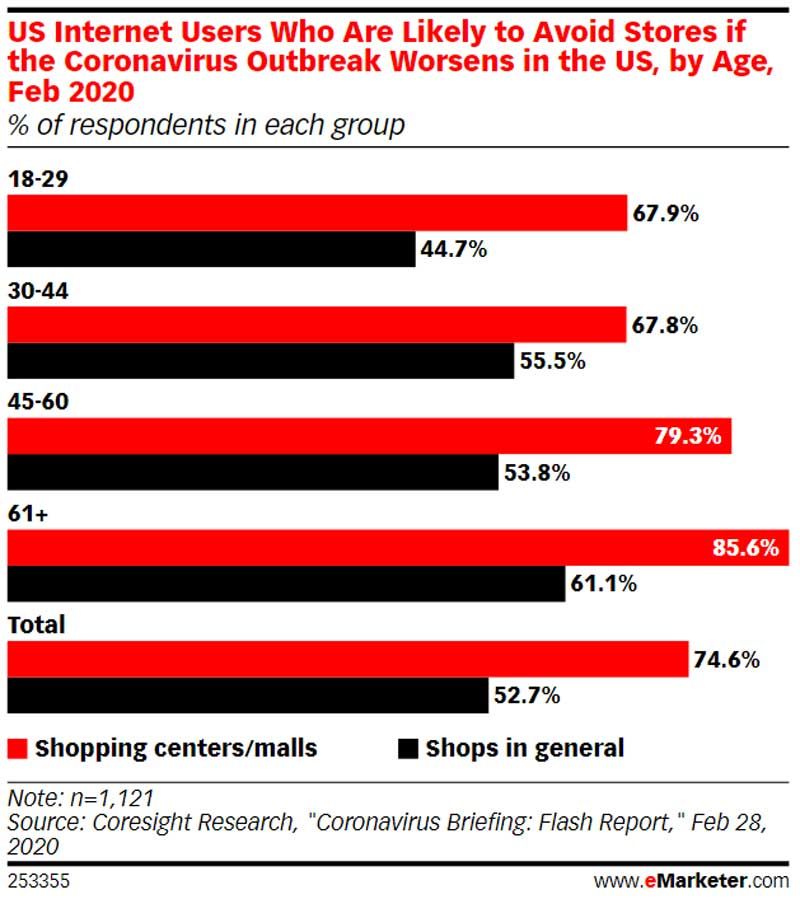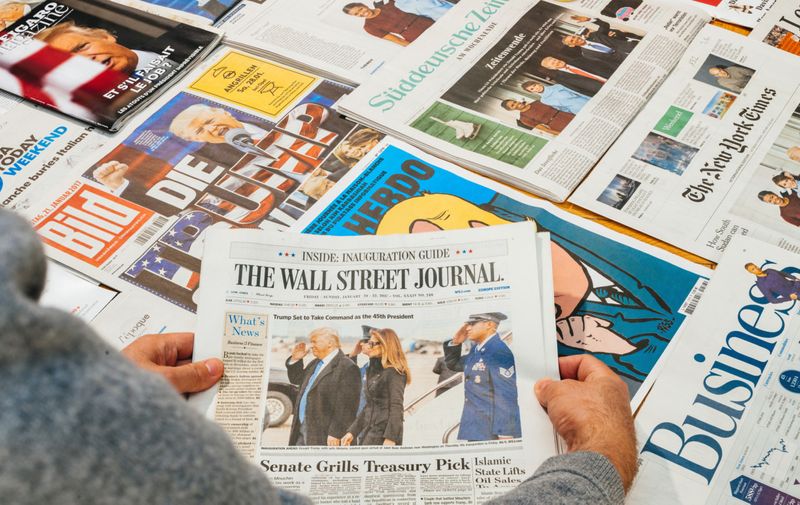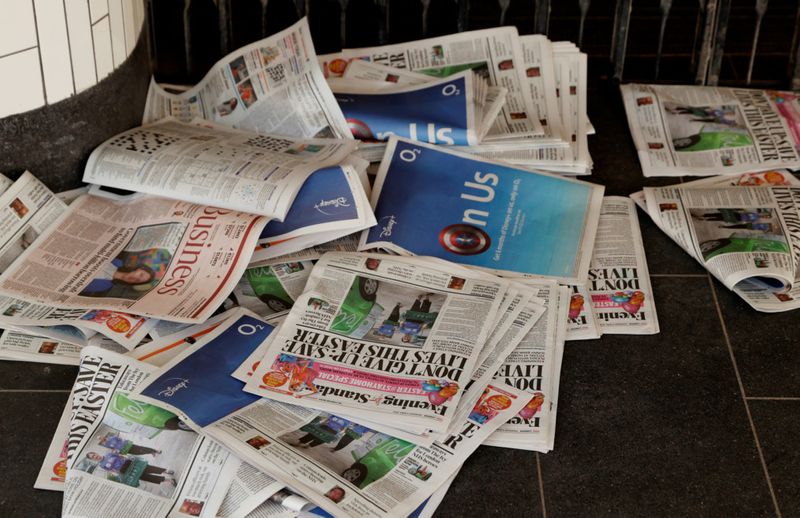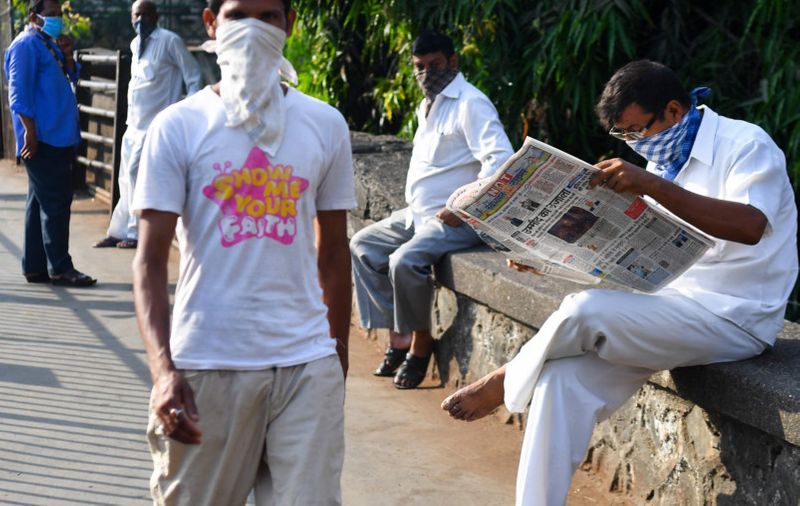
- 88% of global publishing executives expect to miss their business goals this year due to the outbreak
- Media industries in the US and UK have already lost more than Dh500 billion due to coronavirus
- Governments need to protect national media organisations by imposing tax on tech giants and through stimulus packages
- Trustworthy media has never been more needed than now during the coronavirus pandemic
Dubai: The coronavirus pandemic has led to an unprecedented surge in media reporting, phenomenal rise in readership and a relentless demand for reliable news in the past few months.
But in a cruel paradox, while journalists are performing an essential business in diligently covering every aspect of the pandemic, the business of the newspaper itself is facing an extinction-level threat across countries and communities due to collapsing revenues.
According to a Digiday survey, 88% of top publishing executives of legacy media companies expect to be nowhere near their business goals this year due to the outbreak, and 85% also expect to see a sharp decline in advertisement revenues triggered by shutdowns due to the pandemic. The virus, industry experts have warned, will spell the end for hundreds of news companies and titles unless radical intervention measures are adopted by the collective initiative of companies, governments and global tech giants, who have profited for long from the content generated and published by journalists.
Why is the global newspaper industry faced with a catastrophic situation like this?
The novel coronavirus has fatally infected many local and regional newspapers as well as media giants around the world, and industry watchers say the impact of the virus is already far severe than the 2008-09 financial crisis — which led to an average of 19% decline in revenue for newspapers globally, according to Newsonomics.
Those numbers look sobering when compared to the current mayhem.
Consider this:
The media industry in the UK has lost more than 50 million pounds in revenues in two months, according to The Guardian.

Ad spend in the US, tied directly to the state of the economy, has already dropped by at least $80 billion since the outbreak began, according to WWD.
US outlets that are better positioned to survive — such as Washington Post and the Wall Street Journal — had all warned in early March that their ad revenues would take a hit. This was before the COVID-19 outbreak began to climb in the US and virtually shutting down all major cities, putting 22 million Americans out of work as of this week.

I think there will be hundreds, not dozens [of newspaper closures]. An extinction-level event will probably hit the smaller ones really hard, as well as the ones that are part of the huge chains.
Hundreds of titles ranging from City AM to Playboy magazine have already decided to suspend print operations, and thousands more are expected to follow around the world. This would inevitably mean hundreds of thousands of employees in the media sector being laid off or furloughed, and many reputable publishers going out of business.
Penny Abernathy, the Knight chair in journalism and digital media economics at the University of North Carolina, predicts that a vast swath of newspapers and websites will close. “I think there will be hundreds, not dozens,” Abernathy told The Guardian. “An extinction-level event will probably hit the smaller ones really hard, as well as the ones that are part of the huge chains,” she said.
This comes at a time when a majority of newspapers have pulled out all stops to cover the pandemic, despite the uncertainty in the financial situation.
“What is driving triple-digital surges in news publisher traffic and digital subscription worldwide is not just great journalism from trusted news brands, but a smart redeployment of journalistic resources to cover the pandemic,” Earl Wilkinson, CEO of the International News Media Association (INMA), told Gulf News.
What’s the situation like for media in the UAE?

The pandemic clearly caught an already-struggling publishing industry off guard, with ad bookings vanishing at a rapid pace last month. Media companies in the UAE have been exposed to a similar scale of deep damage as most of their counterparts around the world — with March proving to be a nightmare for advertisers in both print and even digital media.
According to Hanover Middle East, there was a decline of more than 40 per cent in ad revenues as most UAE residents and citizens stayed home and cut down on non-essential spending. But the onslaught of coronavirus is the latest in a series of brutal setbacks for media in the UAE, and makes stimulus packages for the sector an urgent necessity for survival.

We have been saying this for a long time, that these media houses – especially the independent ones – need support by governments and organisations to keep them running. Until the economic circumstances come back to normal, there are many ways to help these media houses – in the short term, a stimulus is a must, like any other essential sector.
“It has been happening for a while, more and more traditional media houses have been facing declining revenues — globally and regionally. The UAE is no exception. This has happened because of a market decline in advertising revenue, which used to be a key source of financial support,” said Abdul Hamid Ahmad, Editor-in-Chief of Gulf News and Executive Director — Publications, Al Nisr Media.
“As more and more people move online, traditional media houses have come under immense pressure from big tech giants such as Google and Facebook, which are eating into the revenue. And close on the heels has come the coronavirus pandemic, which has hit very hard, and many newspapers have no option other than to close business or cut costs so drastically that it will impact the depth and quality of their journalism,” he explained.
“We have been saying this for a long time, that these media houses — especially the independent ones — need support of governments and organisations to keep them running. Until the economic circumstances come back to normal, there are many ways to help these media houses — in the short term, a stimulus is a must, like any other essential sector.
“In the long term, there should be policies to protect national media organisations from global giants, by imposing taxation on these tech giants, so that those taxes can benefit national news houses. If nothing of this nature happens, then we will see — globally and regionally — more and more independent papers shutting down,” Abdul Hamid said.
But if millions more people are now reading and following news outlets, why is that not translating into revenue?
The news media business has been on precarious commercial grounds in most places around the world even before the coronavirus outbreak became a pandemic, with smaller and mid-sized independent publishers not affiliated to a conglomerate or the government particularly vulnerable.
Media companies — especially those with print publications — typically relied on advertisement revenue as a major source of their income. These advertisements came from diverse sectors and industries such as retail, travel and tourism, fashion, technology, banking, events and real estate.
With events cancelled, the economic outlook uncertain and most people staying at home, global habits are changing to adapt to the new realities of the outbreak, with far-reaching impact on consumer spending and thereby advertising. For instance, restrictions on movement and large gatherings are leading to lower spending on media strategies and advertisements targeted at consumers outside their homes, as evident from the survey about US internet users below:

Major brands have also lowered their advertising spending based on budget cuts or supply chain issues. Consumers may also reduce spending on non-essential items, which could impact how brands allocate advertising spend across their portfolio of products. Bricks-and-mortar retailers are widely expected to suffer a massive drop in sales. Even big-ticket publishers and broadcasters will face the wrath of the virus with the cancellation of marque music and sport events around the world. For instance, when the US boycotted the Moscow Olympics in 1980, its broadcaster NBC still lost $34 million in revenues despite having insurance.
Thus, with a massive number of businesses paused or closed and no longer willing or able to pay for advertisements, a crucial part of the industry’s support system has cracked. “The traffic and readership numbers are still way up, but the ad contraction is brutal and continuing,” David Chavern, the president and chief executive of US trade association News Media Alliance, told The New York Times.

[Newspaper] advertising revenue is getting just wiped out. And this is not a strong industry or a strong set of businesses going into the virus crisis.”
In many cases, newspaper and digital subscription models have not been robust enough to solely support a media company at a time of crisis like this — few media organisations can claim the scale and scope of a New York Times, which boasts more than 6 million subscribers across platforms and has yet warned of falling revenues in the months ahead.
“[Newspaper] advertising revenue is getting just wiped out,” Ken Doctor, a news industry analyst with Newsonomics, told BuzzFeed. “And this is not a strong industry or a strong set of businesses going into the virus crisis,” he said.
What about digital ads? They should be growing at a time like this?
As the journalism industry attempted to transition from a traditional print-dominated businesses to a world where people get their news on digital platforms, Google and Facebook gobbled up a massive chunk of the advertising revenue that was barely keeping media companies afloat. More than 50% of Facebook’s total revenues comes from small and medium-sized companies — the same local businesses and enterprises that once would once have advertised in the newspaper or the news website.
Even while dealing with those challenges, a triple-digit surge in traffic for major news portals around the world due to the coronavirus coverage should ideally translate into at least a double-digit growth in digital ads.
But with the pandemic getting 24x7 eyeballs and coverage everywhere, many major brands have drastically reduced the number of digital ads it placed on news websites.
In February, “coronavirus” became the second-most common word on block lists for US news publishers, up from eighth-most common in January, according to data provided by Integral Ad Science. The same month, YouTube announced that it would demonetise Coronavirus videos until further notice. In March, brand safety service DoubleVerify found that the volume of content blocked because it was associated with the coronavirus had increased 80% compared to the previous month, Digiday reported.
According to internal industry data reported by BuzzFeed News, more than two million ads of one major global brand were blocked from appearing on US sites such as New York Times, CNN, USA Today and the Washington Post in the first three weeks of March, fearing that such ads would appear next to stories about the coronavirus pandemic. Globally, the unnamed brand’s ads were blocked more than 35 million times across 14 countries in more than 100 news sites, including Der Spiegel, The Guardian and Canada’s Global News. Similarly, a global Fortune 50 company, which spends roughly $3 million a month on advertising on news sites, pulled its campaign last month — reflecting how broad advertiser pullout has damaged the bottom lines at news sites at the same time as readership on those sites has spiked to unparalleled highs.
So are Facebook and Google paying news companies for content?
Not yet in that form — but there are increasing signs of several governments asking the tech giants to compensate traditional media companies for using their content. It will be the first time that major digital platforms have been required to pay for news anywhere.
Australia announced on Monday that it will begin forcing Google and Facebook to pay news companies for content, in a landmark move aimed at shielding traditional media from the tech giants’ digital dominance. Treasurer Josh Frydenberg said a mandatory code of conduct, to be unveiled by July, would require the firms to reimburse Australian media companies for using their news and other content. “What we want to see is a level playing field. What we want to see here is a fair go for the companies and for the journalistic content that is prepared,” he told Channel 7.
A similar measure was adopted in France last week, where the antitrust authorities ordered Google to negotiate with publishers to pay for the news content shown in search results. France’s action stems from a new European Union Copyright Directive, and Germany and other countries will be next.

There are several ways the pressure on Google could be brought to bear… In any case, I believe that Google will eventually be required to treat news publishers, like music publishers, as equals.
Separately, David Chavern of the News Media Alliance, wrote in The New York Times: “There are several ways the pressure on Google could be brought to bear. If Congress passes the Journalism Competition and Preservation Act, publishers would be allowed to negotiate rates with Google as a group. Alternatively, publishers might finally be forced to undertake their own lengthy copyright litigation. In any case, I believe that Google will eventually be required to treat news publishers, like music publishers, as equals.”
What’s the situation like in the US?

While hard data on the impact of the pandemic on the media business is still awaited, there are enough tell-tale signs of widespread damage.
Last year, the legendary billionaire investor Warren Buffett called the US newspaper business “toast” while selling 31 newspapers for $140 million from Berkshire Hathaway to Lee Enterprises.
And last month, Joshua Benton, the director of Harvard University’s Nieman Lab, made a “confident prediction” that 2020 would be the worst year ever for US local media.
According to Jed Kolko, the chief economist at Indeed.com, new listings for jobs in the media and communications sector had fallen by nearly 40% in the 60 days before April 3, compared with the same period last year.
Mark Thompson, CEO of The New York Times Company, took the extraordinary step last week of disclosing in a US Securities and Exchange Commission filing that the Times now expects digital advertising to decline by 10% this quarter.
In a very detailed examination, The New York Times gauged the pandemic’s effects on US media companies and estimated that at least 30,000 employees have been laid off, furloughed or had their pay reduced since the arrival of the coronavirus. Some groups such as C&G Newspapers have moved swiftly to temporarily suspend their print publications:
The scale of job losses, furloughs and pay cuts in the past month in the US has been staggering — from companies and groups as diverse as Chicago Tribune, The New Yorker, Gannett, McClatchy, Gizmodo and Sports Illustrated to smaller and regional titles. Gannett, the largest local newspaper owner in the US, has lost 94% of its value since August 2019. Alden Global Capital, which owns more than 50 newspapers, has issued hundreds of layoffs during the coronavirus outbreak.
How about the UK, Europe and other parts of the developed world?

It’s almost the same story across the Atlantic, where publications such as the London freesheet City AM and the glossy magazine Playboy have stopped print editions and gone digital. Executives and editors at several other publications have said the coronavirus will sound the death-knell for the industry after years of struggle. Ironically, all this comes at a time when sites like the Daily Mail claimed a 50% increase to its home page while viewing figures for TV public service broadcasters are at levels not seen since the financial crisis of 2008.
The largest advertisers of print media in the UK are travel, transport, food, cosmetics and motoring — sectors where almost all the ads have either stopped or are being drastically reduced for the first half of the year. Here is an early forecast of the hit to the global aviation industry, one of the key advertisers on print media:

In places like Australia, the signs are that the crisis will only worsen. Last week, a clutch of Australian papers, including the 120-year-old Yarram Standard and the Great Southern Star, announced they would be shutting down in the face of sharp drops in ad revenue.
How about countries like India? Isn’t traditional media still strong there?

Once upon a time, India’s newspaper industry used to be a vibrant commercial behemoth. It still retains an unparalleled reach of tens of millions of readers every day, but the industry has been severely damaged by declining advertising revenues due to an unprecedented nationwide lockdown to fight the coronavirus.
Advertising revenues at some top dailies of market leader The Times Group and the ABP Group have nosedived as businesses slash ad spending to conserve cash. “Our print advertisement revenue, which is 80% to 85% of our total revenue, is almost zero post lockdown,” DD Purkayastha, chief executive of ABP, which publishes English-language daily The Telegraph and top Bengali language newspaper Anandabazar Patrika, told Reuters.
Titles such as the Times of India, Hindustan Times and Indian Express have all shrunk their pages due to falling ads, and furloughed or laid off employees in the midst of the lockdown.
Indian companies last year spent nearly $9 billion on advertising, including about $2.6 billion on print media, according to a Pitch Madison advertising report. But the Indian Newspaper Society, which represents around 1,000 publishers, has estimated that the national media industry stands to lose more than $2 billion over the next six months, and has urgently sought federal government support through a 50% increase in government advertisement rates.
But doesn’t the world need responsible journalism today more than ever before?
Absolutely — the role of media and the newspaper industry has never been more amplified and the world needs good journalism more than ever now. Trusted media keeps people and countries informed and defends against rumours, half-truths, propaganda and malicious fake news.
In several countries — like in the UAE — media also plays a vital social role by keeping every community accurately informed about the latest developments and by being a responsible partner to government initiatives such as public service announcements, preventive measures and awareness campaigns during the pandemic and beyond.
“The possibility of newspapers closing is incredibly worrisome right now, especially because the information we need around the coronavirus are things at the local level,” Mike Rispoli, director of News Voices, a not-for-profit US news advocacy group, told The New York Times. Rispoli said the closure of local newspapers would leave many readers to seek information from alternative news sources, which are neither reliable nor trustworthy.
That’s why last week, more than 60 regional press titles in the UK published identical front pages with headlines which promised common cause with their local communities. They declared: “We know that for you, having a constant feed of reliable news and information that you trust is vital, and this is our commitment to you: whatever happens, we will be there for you.”
What about the media’s role in combating fake news?
Yet another worrisome risk in the absence of strong and reliable media industry is technology’s ability to spread fake news in the face of an unprecedented health emergency — and Gulf News itself has been at the forefront of busting several such myths.
According to Doctor of Newsonomics, newspapers have a vital role to play during the coronavirus pandemic because it’s a global story, but inherently local, too. People want to know how many cases have been reported in their neighbourhood, what the latest health advice might be, even which parks are closed or open — all classic local news territory. “For clear reasons,” Doctor said. “Given both that people are at home — and scared to death, trying to figure out something that none of us have ever lived through before.”
Most newspaper companies have already stepped up to the challenge.
“Media companies have been very thoughtful and methodical: accelerating coverage and health and safety of employees and customers first, then work-from-home capabilities, then the impact on advertising and how to help small businesses, then forecasts and getting used to this new environment, then making tough calls on right-sizing businesses to the new revenue realities,” says Wilkinson of INMA. “If I were to cut through a lot of conversations, I would say publishers are beginning to turn their attentions less to repairing what is broken and more to accelerating ideas and trends they were already thinking about — but for a myriad of reasons didn’t pursue hard enough fast enough. For example, many are accelerating the shift to digital subscriptions and digital transformation. They’ve long talked about it, some made more investments than others, but there is now a greater sense of urgency,” he told Gulf News.
Who can help the industry? Isn’t media considered an essential business?
Several industry experts, watchdogs and advocacy groups have sought dramatic and innovative solutions to prevent a widespread and permanent damage to the media industry due to coronavirus. Highlighting the plight of the newspaper industry due to the pandemic, the World Economic Forum said in a report: “The financial burden of keeping people informed and entertained may start to shift away from advertisers and onto other stakeholders instead. In the long run this may require greater government intervention.”
Similar calls for government support for independent publishers have echoed everywhere around the world — from the US and the UK to India and Australia.

Protect your brand at all costs. What do the collective actions of your news brand look like in the rear-view mirror of this pandemic? Accelerate trusted journalism… Support your communities, especially vulnerable small businesses. Do extraordinary initiatives for your community, and remind your community that you are here for them.
Media companies themselves also must be willing to fight for survival. “My first reaction is similar to what a lot of people add on to their greetings these days: “and wash your hands.” So my first reaction is: “and watch your balance sheet.” You can do everything correct with your stakeholders, you can produce better journalism, you can find ways to make digital work, yet all this is for naught if your news brand can’t pay its bills,” says Wilkinson of INMA.
“Protect your brand at all costs. What do the collective actions of your news brand look like in the rear-view mirror of this pandemic? Accelerate trusted journalism… Support your communities, especially vulnerable small businesses. Do extraordinary initiatives for your community, and remind your community that you are here for them — wherever they are, in whatever circumstances. With great change and chaos comes great opportunity. What have you always wanted to do as a publisher, but never had the momentum to do? You have to play defense to survive, but at some point you have to go on offense down a new road. That new road — cleared of legacy debris — is almost clear. Will publishers go on offense in this new road, or will they play defense?”
Calls have also grown for the industry to look beyond traditional for-profit models. “We can hope that the current challenges raise awareness and a willingness to pay for news,” Abernathy of the University of North Carolina told The Guardian. “And a willingness to think through new ways of paying for that news — whether it’s through your tax dollars that publicly fund things, or whether it’s actually understanding that newspapers need to charge you more than what they’ve charged you in the past. Because the for-profit model that supported local news for 200 years has collapsed,” she said.
What are the appeals from the newspaper industry for governments?
There are a variety of ideas on how governments could help the newspaper industry while still maintaining the objectivity and independence of media.
In the UK, the general secretary of the National Union of Journalists (NUJ) has warned that several national newspapers were facing financial ruin as a result of coronavirus and would close unless the government found a way to support the industry.
“The [newspaper industry] plays a unique role in our communities … and can’t be treated like any other business. What this crisis demonstrates very clearly is the vital need for trustworthy news. We need to find a way of reimagining this industry,” Michelle Stanistreet told The Guardian, suggesting an immediate windfall tax on tech companies to help support the journalism industry through the crisis.
The NUJ has called for a 6% tax on the revenues of tech companies such as Google and Facebook, with the proceeds used to rescue the journalism industry. It also called for tax credits and interest-free loans to support journalists’ jobs and investment in news outlets. In addition, it also asked the government to confer “asset of community value” status on local newspapers, ensuring that financially stricken newspapers are preserved for potential community ownership.
In the US, Craig Aaron, president and co-CEO of Free Press, has proposed a government stimulus package that would double federal funds for media, provide direct support to fund local news coverage, and seed a “First Amendment Fund” to support new positions and approaches to newsgathering. The proposal received strong support from many media outlets, including the Atlantic, which urged that government “funnel $500 million in spending for public-health ads through local media” as part of its future stimulus plans.
In India, media executives have asked the government to clear advertising dues by the Directorate of Advertising and Visual Publicity (DAVP) and other government-owned bodies to help media companies tide over cash flow problems and avert possible job losses. As per various industry estimates, DAVP owes up to Rs18 billion to various print media companies and overall, government advertising constitutes about 5% of Indian print media’s annual ad revenues.
What have governments around the world done to help the newspaper industry?
With media experts at Enders Analysis warning of widespread destruction of the British news industry, with the loss of tens of thousands of jobs, the British government has initiated a critical dialogue with representatives of the industry and the government has stepped up its spending on public information advertising to support local outlets.
In Australia, the government has announced a package of measures to help sustain Australian media businesses as they do what it said was “vital work of keeping the community informed during the COVID-19 pandemic’.
As part of the measures, commercial television and radio broadcasters will receive a 100% tax rebate for 12 months, reflecting a total savings of $41 million. It also set up a $50-million Public Interest News Gathering (PING) programme to support public interest journalism delivered by commercial television, newspaper, and radio businesses in regional Australia, saying: “The government recognises that public interest journalism is essential to informing local communities, particularly national and global events such as COVID-19.”
Has anyone else rolled out any help?
Tech giants like Facebook and Google have rolled out measures intended to help the media industry — but the jury is still out on whether the scale of help offered is adequate.
Facebook announced it would invest $100 million to support media businesses during the coronavirus pandemic, with $25 million in emergency grants going to local outlets and $75 million more for marketing to help those struggling to survive the current decline in advertising. The New York Times reported that this money comes in addition to the $300 million that Facebook already committed to local news by the end of 2021. “If people needed more proof that local journalism is a vital public service, they’re getting it now,” said Campbell Brown, the former NBC News journalist, who now serves as Facebook’s VP of Global News Partnerships. “And while almost all businesses are facing adverse financial effects from this crisis, we recognise we’re in a more privileged position than most, and we want to help.”
The extraordinary situation has also prompted Google to launch a global emergency relief fund for local news publishers through its Google News Initiative to deliver help to “thousands of small, medium and local news publishers globally.”
What can media companies do to survive this?
In 2019 a Pew study in the US found that 71% of people believe that their local news organisations were doing very well financially, while the reality was that they were struggling to stay afloat. Demolishing such myths could help, along with evolving according to the situation, says Wilkinson of INMA.
“Follow the data. What are people reading? What are they interested in? Do you have a culture in your newsroom to respond quickly? We talked with executives at La Repubblica in Italy in recent weeks. It’s interesting to hear their path. They saw a 50% increase in digital subscriptions as people shifted from social platforms to trusted news brands in a pinch. They also told us how people shifted their interest from death counts to stories of hope and reinvention — and La Repubblica shifted with them. The question is whether this is a one-time surge. Or can publishers engage with new readers? Can we make them super-fans of our brand? How do we turn “like” to “love”? Journalism alone can’t do it. You’ve got to have all of the engagement mechanisms in place to make that work,” he said.
It’s often said that the media loves a crisis. It was unprepared for an unprecedented crisis such as this, but it’s certainly worth fighting for — because everything is at stake for countries, communities, journalists and the media businesses themselves.








